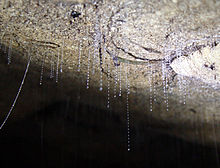| Arachnocampa luminosa | |
|---|---|

| |
| Glowworm (Arachnocampa luminosa) and silk snares | |
| Scientific classification | |
| Domain: | Eukaryota |
| Kingdom: | Animalia |
| Phylum: | Arthropoda |
| Class: | Insecta |
| Order: | Diptera |
| Family: | Keroplatidae |
| Genus: | Arachnocampa |
| Species: | A. luminosa
|
| Binomial name | |
| Arachnocampa luminosa (Skuse, 1891)
| |
| Synonyms | |
| |
Arachnocampa luminosa (Skuse, 1891), commonly known as New Zealand glowworm or simply glowworm, is a species of fungus gnat endemic to New Zealand. The larval stage and the imago produce a blue-green bioluminescence.[2] The species is known to dwell in caves and on sheltered banks in native bush where humidity is high.[3] Its Māori name is titiwai, meaning "projected over water".[citation needed]
The first written record of the species dates from 1871 when it was collected from a gold mine in New Zealand's Thames region. At first it was thought to be related to the European glowworm beetle (Lampyris noctiluca) but, in 1886, a Christchurch teacher showed it was a larva of a gnat, not a beetle.[2] The species was first formally described in 1891 with the species name Bolitiphila luminosa and was assigned to the family Mycetophilidae.[4] In 1924, it was placed within a new genus of its own, Arachnocampa, because the wing venation of the adults and the behaviour of the larvae differed significantly from other Bolitophila fly species.
- ^ Gatenby, J. Bronte (May 1960). "The New Zealand Glow-Worm". Tuatara: Journal of the Biological Society. 8 (2): 86–92. Retrieved 27 July 2015.
- ^ a b Richards, A. M. (1960). "Observations on the New Zealand Glow-worm "Arachnocampa luminosa" (Skuse) 1890". Transactions of the Royal Society of New Zealand. 88: 559–574.
- ^ Meyrick, E. (1886). "A luminous insect larva in New Zealand". The Entomologist's Monthly Magazine. 22: 266–267.
- ^ Skuse, F A A (1891). "Description of a luminous dipterous insect (fam. Mycetophilidae), from New Zealand". Proceedings of the Linnean Society of New South Wales. 5: 677–679. doi:10.5962/bhl.part.18661. ISSN 0370-047X.